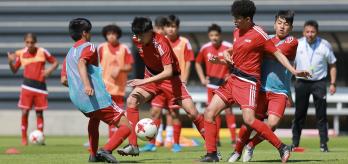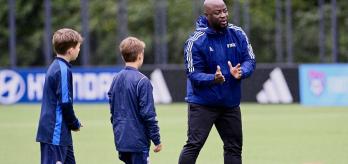Skill acquisition science only arrived in the world of football relatively recently, but it offers some tantalising opportunities for coaches, including the potential to help them calibrate individual training sessions to get the most out of their squads. In this presentation for the FIFA Training Centre, Dr Job Fransen provides an introduction to the discipline, and suggests how coaches can make best use of it. The session is followed by a Q&A, hosted by Dr Paul Bradley.
Explain some of the fundamental principles behind skill acquisition science (SAS) and why coaches should care about them. Show how applying those principles can help coaches find the “sweet spot” that will promote long-term learning in their players.
The body of evidence in this area is relatively limited, particularly in a football context. However, an understanding of SAS has the potential to help coaches assess how their players’ acquire skills in a more systematic way, determine whether they have really internalised what they have been taught, and adapt their training sessions to get the biggest possible improvements from their squads.
Coaches should consider applying SAS to help them understand how much their players are learning and find the "sweet spot" in their training methodology. Ideally, exercises should be challenging enough to take players to their limits, but not so difficult that they damage their confidence on matchday. A knowledge of SAS may make it easier to find that balance.
Watch presentation
Read summary
Part 1: An introduction to skill acquisition science
Skill acquisition science aims to improve our understanding of how humans learn physical skills. When applied in a sporting context, it borrows heavily from a number of related disciplines, including sports psychology, neuroscience, motor development studies and coaching science. As Dr Fransen explains, many coaches apply the principles of SAS instinctively without studying them. However, coaches who are consciously aware of SAS may have more tools at their disposal to assess their players’ progress, and could be better equipped to facilitate genuine learning on the training ground.
Part 2: How to tell whether a skill has been learnt
At the very heart of SAS lies the distinction between the ability to perform an activity in a controlled environment and genuine, transferrable learning. A player might look like they’ve got the hang of a technique on the training ground, but it’s not until they can apply it instinctively in matches over a sustained period of time that they can really claim to have mastered it. In this section, Dr Fransen explains how coaches can spot whether a player has really internalised what they’ve been taught, and how they can put that learning to the test under stress.
Part 3: Learning from mistakes and the importance of errors
Finally, Dr Fransen explains how coaches might tailor their training to promote genuine learning. The main challenge is to find a balance between boosting confidence and training to learn. Coaches can build confidence by making training easier, but training to learn has to be challenging enough for players to move outside their comfort zones, which naturally results in errors being made. While allowing players to explore their limits may help them learn, making training too difficult may give rise to frustration, and can actually impair performance and learning.
Q&A
00:18
My first question is about the composition of your presentation. There was a lot of coverage of meta-scientific work. What is meta-scientific work, and why should coaches care about it?
02:31
There are a lot of sensationalist claims made using scientific data, especially in the commercial domain. Why should we be slightly sceptical in this area, and what does that scepticism mean for the way we approach skill acquisition science?
05:11
Skill acquisition science is a relatively new area of research within football. Where should practitioners start if they want to get to know this new area?
07:36
We know that on-field training is key for footballers, but are there any off-field training techniques that can supplement on-field practice, such as virtual reality or augmented reality?
09:59
From a more practical angle, how important is it to add variability into training, and how much time should coaches spend varying their training sessions?
12:29
What are the practicalities of incorporating unstructured practice into training sessions?
15:05
How can coaches optimise instruction? How much time should players be given in training sessions to work things out by themselves?
18:37
In terms of the science of skill acquisition, what are the key aspects for practitioners to consider?
 16-9.variant64x64.JPG)







 16-9.variant348x164.JPG)






